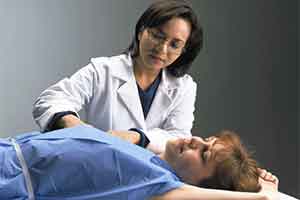Physicians Performing Breast Exams May Miss Masses Deep in Breast
New sensor technology finds many doctors may not be pressing hard enough
 Many physicians who tested their breast-examination skills on a new type of pressure-sensing breast model failed to detect masses deep in the breast because they were not pressing hard enough, a study has found.
Many physicians who tested their breast-examination skills on a new type of pressure-sensing breast model failed to detect masses deep in the breast because they were not pressing hard enough, a study has found.
“They were not doing the exams the right way, even though they had been doing exams for many years,” said William C. McGaghie, PhD, of Loyola University Chicago Stritch School of Medicine, a co-author of the study published in the New England Journal of Medicine. Principal investigator is Carla M. Pugh, MD, PhD, of the University of Wisconsin School of Medicine and Public Health.
The study illustrates the potential for using sensor technology to improve how physicians’ clinical exam skills are assessed, researchers wrote in a correspondence to the journal. “Integration of sensors into clinical-skills assessments may allow for objective, evidence-based training, assessment and credentialing.”
Dr. McGaghie said other research has demonstrated the value of similar sensor technology on chest models. The sensors can assess whether a healthcare worker practicing CPR compressions is pressing hard enough.
The new study involved a prototype breast model with embedded sensors. As a physician palpates the breast model during a simulated exam, the sensors can detect the location and depth of pressure.
Four breast models with sensor technology were used. In two models, a mass was located near the surface. In the other two models, masses were located deep inside the breast, near the chest wall.
Using the models, researchers tested 553 physicians recruited at three annual clinical meetings in 2013 and 2014: 136 at the American Society of Breast Surgeons, 236 at the American Academy of Family Physicians and 181 at the American College of Obstetricians and Gynecologists. The physicians were asked to perform a simulated clinical breast exam under conditions that mimicked an office visit for a symptomatic patient. The physicians were told the patient believed she had felt a mass during a self exam, but could no longer feel it.
Analysis of the sensor data showed a significant relationship between the force used during palpation and the accuracy of the exam. Physicians who pressed with a force of less than 10 newtons were at significant risk for missing deep-tissue masses. (A newton is a unit of force; one newton is equivalent to the weight of a median-size apple.) However, if the mass was near the surface, accuracy did not improve by applying more force.
“Since variations in force cannot be reliably measured by means of human observation, our findings underscore the potential for sensor technology to add value to existing, observation-based assessments of clinical performance,” researchers wrote.
The correspondence to the New England Journal of Medicine is titled “Sensor Technology in Assessments of Clinical Skill.” In addition to Loyola and the University of Wisconsin, other institutions involved in the study are the University of Illinois at Chicago College of Medicine and the Foundation for Advancement of International Medical Education and Research in Philadelphia.
Source Newsroom: Loyola University Health System
Citations
New England Journal of Medicine

